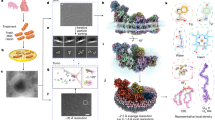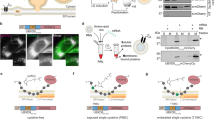Abstract
The capacity of the rough endoplasmic reticulum (RER) membrane of eukaryotic cells to translocate nascent presecretory proteins from the cytosol to the intracisternal space is preserved on cell fractionation and can be assayed in vitro1. Two attempts to characterize this translocation activity have been reported. Warren and Dobberstein2 reported that microsomal membranes can be depleted of their translocation activity by extraction with a solution of high ionic strength (500 mM KCl) and that activity can be restored to the depleted membranes by re-addition of the salt extract. On the other hand, Walter et al.3 reported that KCl extraction of the microsomal membrane does not result in complete depletion of its translocation activity. However, mild trypsinization of the microsomal membrane released a tryptic fragment(s) from the membrane which, when recombined with a tryptically inactivated membrane fraction, restored translocation activity3. We now show that both the trypsin and the KCl extracted factors, but not the membrane-integrated remainder of the translocation apparatus, contain at least one sulphydryl group that is essential for activity.
This is a preview of subscription content, access via your institution
Access options
Subscribe to this journal
Receive 51 print issues and online access
$199.00 per year
only $3.90 per issue
Buy this article
- Purchase on Springer Link
- Instant access to full article PDF
Prices may be subject to local taxes which are calculated during checkout
Similar content being viewed by others
References
Blobel, G. & Dobberstein, B. J. Cell Biol. 67, 852–862 (1975).
Warren, G. & Dobberstein, B. Nature 273, 569–571 (1978).
Walter, P., Jackson, R. C., Marcus, M. M., Lingappa, V. R. & Blobel, G. Proc. natn. Acad. Sci. U.S.A. 76, 1795–1799 (1979).
Lingappa, V. R., Devillers-Thiery, A. & Blobel, G. Proc. natn. Acad. Sci. U.S.A. 74, 2432–2436 (1977).
Shields, D. & Blobel, G. Proc. natn. Acad. Sci. U.S.A. 74, 2059–2063 (1977).
Katz, F. N., Rothman, J. E., Lingappa, V. R., Blobel, G. & Lodish, H. F. Proc. natn. Acad. Sci. U.S.A. 74, 3278–3282 (1977).
Shaw, E. in The Enzymes 3rd edn, Vol. 1, 71–147 (Academic, New York, 1970).
Jackson, R. C. & Blobel, G. Ann. N. Y. Acad. Sci. (in the press).
Jackson, R. C. & Blobel, G. Proc. natn. Acad. Sci. U.S.A. 74, 5598–5602 (1977).
Dobberstein, B. & Blobel, G. Biochem. biophys. Res. Commun. 74, 1675–1682 (1977).
Blackburn, P., Wilson, G. & Moore, S. J. biol. Chem. 252, 5904–5910 (1977).
Shields, D. & Blobel, G. J. biol. Chem. 253, 3753–3756 (1978).
Author information
Authors and Affiliations
Rights and permissions
About this article
Cite this article
Jackson, R., Walter, P. & Blobel, G. Secretion requires a cytoplasmically disposed sulphydryl of the RER membrane. Nature 286, 174–176 (1980). https://doi.org/10.1038/286174a0
Received:
Accepted:
Issue Date:
DOI: https://doi.org/10.1038/286174a0
Comments
By submitting a comment you agree to abide by our Terms and Community Guidelines. If you find something abusive or that does not comply with our terms or guidelines please flag it as inappropriate.



